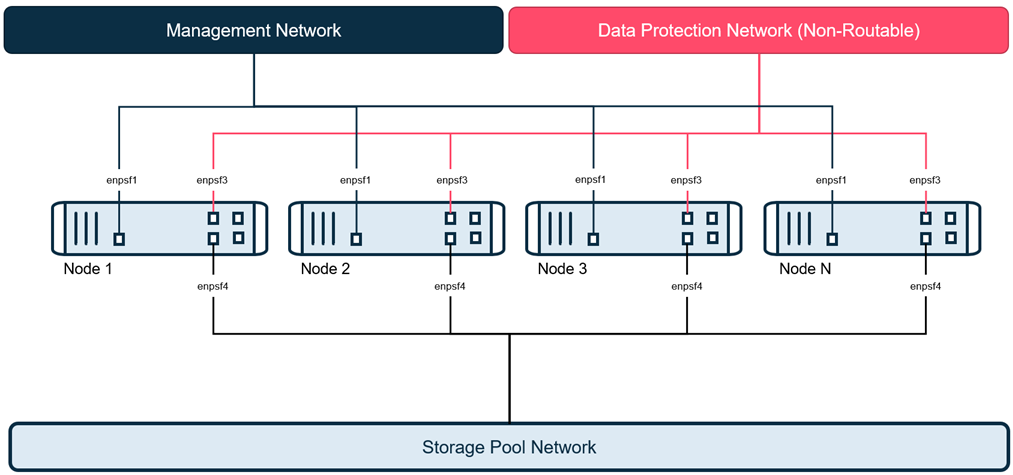This topology combines the basic topology with a 1 GbE management interface.
This can be used in cases where the data protection network will be on a non-routable backup network, and therefore an additional management interface is required. This topology leverages one of the built-in 1 GbE copper interfaces for management traffic and will require additional cabling.
In this topology, each node requires connections to 3 separate network as follows:
-
1 - 10 GbE port for data protection network, which transfers data to and from the clients being protected and connect to the CommServe server.
-
1 - 10 GbE port for storage pool network, which is a dedicated private network, used for communication and replication between the HyperScale nodes.
-
1 - 1 GbE port for management network, which is used exclusively for all management related communication, such as connecting to the CommServe server, accessing the DNS server, etc.
Note
Basic topology is the easiest option to setup and deploy. However, this topology does not provide network redundancy, and is recommended only for non-production use, or if you do not have the required port availability for redundant connections. Combine the basic topology with a Management network if the HyperScale X Reference Architecture nodes are located in an isolated backup network.

Network Requirements
In this topology, each node requires the following connections:
-
1 - 10 GbE port for the data protection network,which transfers data to and from the clients. This requires a corresponding IP address for the data protection network.
-
1 - 10 GbE port for the storage pool which is a dedicated private network, used for communication and replication between the HyperScale nodes. This requires a corresponding IP address for the storage pool network.
-
1 – 1 GbE port for the management network, which is connected to a routable network with DNS access. This requires a corresponding IP address for the management network.
Note
Data Protection, storage pool and management networks MUST be on separate subnets.
The following network names and IP addresses are required for the 1 GbE management topology:
|
Node 1 |
Node 2 |
Node 3 |
Node n |
|
|---|---|---|---|---|
|
Data Protection Fully Qualified Domain Name* |
|
|
|
|
|
Data Protection IP Address* |
|
|
|
|
|
Data Protection Netmask* |
|
|
|
|
|
Data Protection Gateway* |
|
|
|
|
|
Data Protection DNS 1* |
|
|
|
|
|
Data Protection DNS 2 |
|
|
|
|
|
Data Protection DNS 3 |
|
|
|
|
|
Storage Pool IP Address* |
|
|
|
|
|
Storage Pool Netmask* |
|
|
|
|
|
Data Protection Network Interface MAC 1 (OS Port Name 1) |
|
|
|
|
|
Node Data Protection Network Interface MAC 2 (OS Port Name 2) |
|
|
|
|
|
Storage Pool Network Interface MAC 1 |
|
|
|
|
|
Storage Pool Network Interface MAC 2 |
|
|
|
|
|
Management IP Address* |
|
|
|
|
|
Management Netmask* |
|
|
|
|
* Required fields Each node should be resolvable to the CommServe server.
Note
If you have more than 3 nodes expand the columns in this table to include all the nodes that you plan to setup.
CommServe Requirements
You will require the following information to connect to an existing CommServe server:
|
CommServe hostname (FQDN) |
Fully qualified hostname (FQDN) associated with the existing CommServe server. Note TCP Ports 8400 & 443 must be open from the nodes to the CommServe server. |
|
Username |
Username associated with the admin user. |
|
Password |
Password for the admin user. |
